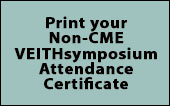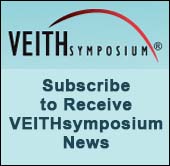THE HISTORY, FEATURES, MISSION, PHILOSOPHY/CHARACTER AND FUTURE VISION OF THE VEITHsymposium
HISTORY AND DEVELOPMENT
The VEITHsymposium (Vs) grew out of a small meeting started in the early 1970s by Henry Haimovici. The early meetings, which were held in the Roosevelt Hotel in New York City, were sponsored by Montefiore Medical Center. The meeting had a 2-page program, 10-15 Faculty members and attracted less than 100 attendees. After the first three meetings, Frank J. Veith succeeded Dr. Haimovici as Chief of Vascular Surgery at Montefiore and Albert Einstein College of Medicine and became the Chairman of the meeting. Over the next 4 decades, as vascular surgery grew and matured as a specialty, the meeting has grown in size, scope and international flavor. It now attracts about 5,000 attendees, has about 600 faculty members and its program fills 128 pages with over 100 exciting and provocative sessions.
The meeting's growth, importance and success are based on several factors and some good luck. The most important has been the emergence of vascular surgery as a specialty and the evolution of a myriad of new developments in and treatments for non-cardiac vascular disease. These treatments have included dramatic improvements in medical treatment, the transformative introduction of endovascular treatments including endografts as well as a plethora of new, effective operative techniques. This explosive growth of vascular treatments mandates that all vascular specialists commit to non-cardiac vascular disease as an area of interest and stay up-to-date with current advances in that area. This in turn can only be accomplished by attendance at balanced, unbiased CME meetings such as the VEITHsymposium. There is no substitute for such meetings. Textbooks and journals help, but can never be as balanced and up-todate as our meeting. Moreover, the interaction with other attendees, faculty and industry representatives is an invaluable way for vascular surgeons and other vascular specialists to keep up with current developments that allow them to treat their patients optimally. Such interactions along with presentations of all the key latest developments happen at our meeting.
FEATURES, PHILOSOPHY/CHARACTER AND MISSION OF VEITHsymposium
One asset of our meeting is its location in New York City, an easy place to get to from all parts of the world. This has contributed greatly to the large numbers of out-of-US faculty and attendees. These out-of-US participants in turn keep US attendees and faculty apprised of the advantages and results of newer technologies, the use of which is sometimes restricted or delayed in the US because of stricter FDA requirements to demonstrate safety and effectiveness.
Other FEATURES of VEITHsymposium have evolved, often fortuitously, over the last 2-3 decades. One is the dedication to short talks, most recently taking up to 5-6 minutes. This grew out of our desire to include as many speakers as possible, often from different specialties and with widely divergent views. This feature also restricted presentations to the essential kernel of key new and exciting information that each speaker wanted to contribute. It has also largely eliminated presentation of unnecessary or repetitive information. Most importantly it has minimized faculty bias and provided an optimally balanced view of competing techniques and technologies because most topics are addressed by multiple authors. This format has in turn allowed VEITHsymposium to fulfil its PRIMARY MISSION of providing vascular surgeons and other specialists with a complete overview of the most up-to-date, unbiased and balanced state of the art in vascular treatment as well as what important new developments are on the horizon.
The idea of short talks arose when we saw television news interviews of important officials such as an ambassador or cabinet member. These interviews seldom lasted more than 3 minutes but covered the essential points of interest and left the audience wanting to hear more. Knowing that all faculty members only had precisely 5-6 minutes to speak made them prepare better and focus their remarks only on the key points they wished to get across. After our meeting pioneered the short-talk-by-experts format and our innovative techniques for keeping speakers to time, other meetings around the world adopted similar methods almost universally. This allows meetings to run precisely on schedule so attendees can reliably catch the talk they want to hear, even when there are concurrent sessions.
A second key feature of our meeting has been the introduction of a collegial relationship with industry. Making medical device and pharmaceutical companies partners in our educational effort was at first considered commercialization or a “no no” when we first introduced it. However, it soon became obvious that our industry colleagues are essential partners in improving the care of vascular patients. This doctor/industry partnership was apparent before the endovascular revolution, but it became even more essential in the endovascular era. Physicians and surgeons can have the ideas for creative new treatments, but we need the engineering and financial resources of industry to develop these ideas and bring them to clinical fruition. Moreover, meetings such as ours would not be possible without the financial support of industry. There is no way that physician registration fees could bring a large faculty of experts from around the world to such a meeting without industry support.
The possibility of unfair promotion of industry's products and conflicts of interest on the part of faculty has been raised as reasons to separate doctors from industry; and abuses have occurred. However, strict new CME rules and the multi-faculty, short talk nature of meetings such as ours minimize the possibility of biased and conflicted presentations. Moreover, when making up our program, we make an effort to include debates and contrary views that prevent our meeting from presenting infomercials. Airing of conflicting views and exposing all sides of controversial topics also brings excitement and energy to our meeting and helps it to hold the attention of our audience. Our PHILOSOPHY is to make up a program with topics that everyone wants to see and hear - a program that everyone has to attend.
A third key feature of VEITHsymposium is the availability of a library that captures our entire meeting - all the talks, slides and panel discussions, indexed to our program and by topic and presenter. This library, which is enabled by recent advances in computer technology memorializes our meeting and makes it possible for attendees to view and hear parts of the meeting that they may have missed or want to review again. It is a unique resource which overviews the state of the vascular art at the time of the meeting. It can be used for teaching, review, patient management and as a guide to the literature. The library is also available to those who cannot attend our meeting and to our industry partners.
A fourth innovative feature of our meeting (often adopted by other meetings) has been the introduction of the Associate Faculty Program. This program gives an opportunity to all those interested in contributing scientifically to the program by presenting their ongoing clinical research work. Young and upcoming vascular specialists, as well as experienced practitioners are encouraged to submit to this program. This program not only reflects our commitment to such individuals, it also allows them to reference their contributions as literature citations since their abstracts are published and listed on our web page. Being on our Associate Faculty also enhances their opportunity to attend our meeting and to experience its other parts.
Finally, VEITHsymposium was the first vascular surgery organization to bring together at one site radiologists, cardiologists, cardiac surgeons and vascular medicine specialists with vascular surgeons to exchange information and scientific innovations in a collegial environment. This allows members of each specialty to profit from learning the unique skills and approaches of other specialties, thereby improving their ability to care for vascular patients.
ORGANIZATIONAL STRUCTURE AND AFFILIATION
Our meeting has, since 2006, been owned and operated by the VEITHsymposium LLC. Our meeting is sponsored and CME accredited by the Cleveland Clinic which is, per ACCME guidelines, responsible for handling all financial matters related to the meeting (i.e., accounts payables and receivables and providing CME certificates to attendees).VISION FOR THE FUTURE
Our intention is to have our meeting continue indefinitely. We aim to keep what is good about it and add components and ideas to make it better. We want to increase its value to all vascular specialists and to our vascular industry partners. So we welcome suggestions from all. Location: The meeting will continue to be held in New York City (NYC), a unique place with many advantages as stated above. Hotel: We also believe there are many advantages to holding the VEITHsymposium in a large hotel rather than at a convention center which in NYC would require busing with the disadvantage of horrendous traffic delays. However, if the topography of NYC and hotel availability changes, we would consider other arrangements. We recognize the importance and contributions of other specialties to the care of vascular diseases. So our intent is to make our meeting more multi-specialty than it already is (25% of our speakers are currently from specialties other than vascular surgery). To that end, we will add more experts in other specialties (interventional cardiology, interventional radiology and vascular medicine) to our leadership team and increase their involvement in program development. Our goal is that by so doing we will attract more non-vascular surgeon attendees since the quality of our program contains so much information that these other specialties have to know, but do not get at their specialty meetings. Increasingly CME rules and regulations around the world are making it more difficult for industry to support medical education. We believe relationships between doctors and industry are beneficial to patients and society - if they are managed properly and fairly, which we believe our meeting does within the rules that exist, and will continue to do within rules that may be added. Succession Planning: Finally it is obvious that the value and quality of the VEITHsymposium is dependent on its leadership and staff. Since no one lasts forever, we have in place a succession plan that will continue to run the meeting so as to maintain its quality, value and energy level. Details and staffing may change, but it is our hope and plan that VEITHsymposium continues for a long, long time and remains the top US and Global vascular meeting indefinitely.










![[Clevel]](flash/badge-cleveland-clinic.jpg)



